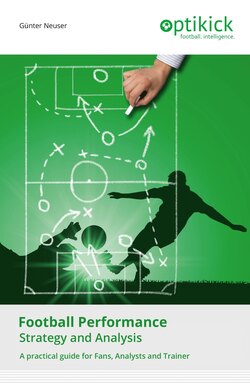Читать книгу Football Performance - Günter Neuser - Страница 9
ОглавлениеThe Performance Model
The general performance model for sports games
The prerequisite for a systematic, i.e. plannable and controllable performance development of players and teams through objective-oriented training and realization in competition as well as its measurement and evaluation is a general model for the structure of sports performance.
Picture 6 The general sport performance model
The achievement of sport performances in training and competition depends on various conditions, which must be known.
The personal and team performance prerequisites are influencing factors, that determine the level or quality of a performance and its development.
These include:
a. Condition (strength, endurance, speed and mobility skills)
b. Technical coordination (movement and coordination skills)
c. Tactics (ability to analyse, decide and adapt to situations)
d. Constitution (constitutional requirements)
e. Personality (cognition, emotion, motivation).
The entirety of the personnel and team prerequisites for coping with the performance requirements makes up the performance capability.
The actions of players individually and in the context of tactical groups and the team are the game actions to be observed.
All game actions are objective-oriented and can have a positive (e.g. goal-shot) or negative (e.g. ball loss) result, the so-called game effectiveness.
The scope and results of the game performances are influenced by internal and external factors.
The game actions with their results (the game effectiveness) as well as the information on internal/external influences are summarised in the competition behaviour.
Competition behaviour is recorded by means of observation procedures, while ability and skill diagnostics, in particular by means of test procedures, are used to determine the performance prerequisites.
The football specific performance model
The characteristics of the football game (including the rules of the game, the pitch, the number and roles of players) and the resulting demands on performance and its development require a football specific performance model.
Picture 7 The football specific performance model
External influences (1) are factors outside the field of play (e.g. field conditions, weather) with a possible positive or negative influence on the performance of players and teams.
Internal influences (1) are events or conditions (e.g. substitutions, injuries of players) that ultimately affect the team squad and its strength.
The football-specific condition (2) is a prerequisite for the application of technical and tactical actions throughout the entire season. Condition is the collective term for all mental, physical, cognitive and social performance factors.
The football technique (3) covers techniques with the ball (including passing, shooting, dribbling) and techniques without the ball (including running and jumping techniques or tackling) for all coordinative skills or movements (with and without the ball). The mastery and successful application of the football techniques is a prerequisite for the desired success of the tactical actions.
Tactics (4) in football encompasses all individual and collective attacking and defensive procedures of a team, which are applied on the basis of a tactical concept, taking into account the adopted game plan of the opponent and taking into account the diverse playing conditions as well as concrete situation developments, in order to achieve an optimal game result in the tactical game phases and standards.
Classic game situations in the area of individual tactics are dribbling, crosses, passing and the 1-on-1 game. Group tactics describe the coordinated action of at least two players in attack or defence. The group tactic is the result of several individual actions. Simple examples are wing play, certain passing sequences and overcount play. Examples that explain the term team tactics are the defensive tactics or offensive tactics as a predetermined way of playing for the whole team. Team tactics also includes tactical formation (e.g. 4-4-2, 4-2-3-1, 4-5-1).
In order to define typical tactical behaviour patterns and reduce the complexity of the football game, the game is divided into game situations. At the highest level of aggregation, these game situations are phases of play with / without the ball and standards in offensive and defensive with their sequence relationships. These game phases themselves contain further tactical actions, which also have logical sequence relationships with each other.
The tactical actions are ultimately based on the technical actions, such as passing, crosses, goal kicks and duels.
The playing style (5) is the methodical description of the specific way of playing football. A specific style of play is defined, among other things, by determining the characteristics of the game actions. A playing style can exist in different forms for an entire club, a year group, a team and team parts (tactical groups / positions).
